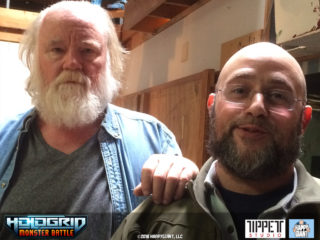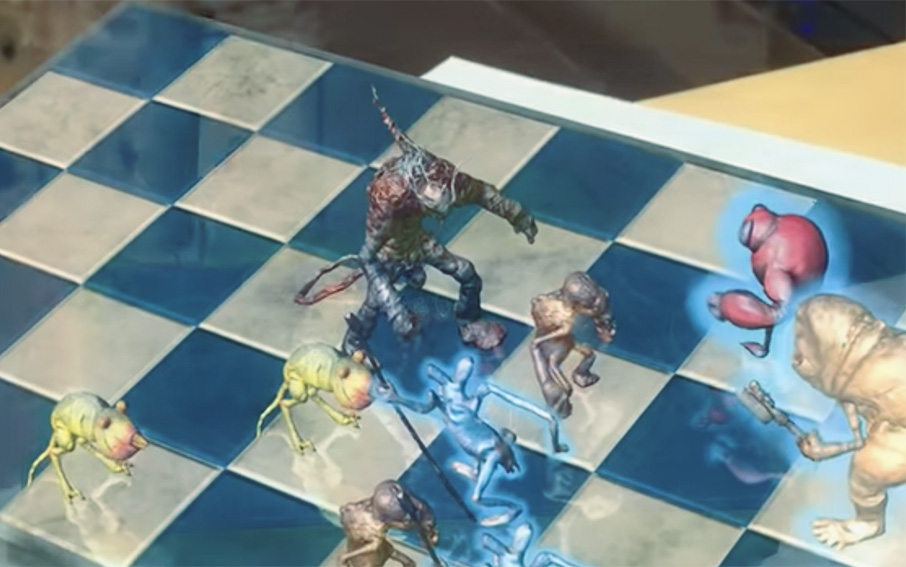HoloGrid: Monster Battle is an augmented reality, tactical strategy multiplayer game similar to Dejarik aka “Holochess“ in Star Wars. Just like Dejarik—which you should always let the Wookie win—the creatures in HoloGrid were designed by Industrial Light and Magic (ILM) veteran Phil Tippet. The game itself was developed by HappyGiant, a company founded by veterans of LucasArts, ILM, Hasbro and Pileated Pictures.
The game combines elements of collectible card games, board games and digital games for mobile devices. While inspired by Star Wars, HoloGrid: Monster Battle is definitely a unique creature all its own. Previously launched as a physical goods AR game on iOS and Android, a new digital-only Tango AR version has just been released on Google Play.
HappyGiant CEO Michael Levine joined AListDaily to share the origins of HoloGrid: Monster Battle, the game’s inspirations and the challenges of marketing for AR.

How did the partnership between HappyGiant and Tippett Studio come about?
I worked for LucasArts for most of the ’90s in the art department. I was often tasked with coming up with new art paths and methods to make our new games. Tech was changing so fast back then—every game had new issues to deal with. This brought me in close contact with ILM, as we were often trying to solve the same or similar problems, using new tools that were emerging. Ultimately I left LucasArts to help form Puffin Designs, a software tools company eventually sold to Pinnacle, with many of the folks from ILM I had become friends with. Some of these people now run and work at Tippett Studio. Corey Rosen and I began talking about doing something together a couple years back. We did not set out to make a game like this. We were doing photogrammetry tests, and it kind of led us to this very organically.
The similarities between Holochess in Star Wars and HoloGrid are obvious, but what other games or genres inspired this project?
I can say with certainty that the similarities [between the two games] for the most part are purely aesthetic, as having discussed this with Phil [Tippett]—there was literally no thought put into “gameplay” when they made the scene 40 years ago for Star Wars. That was one of the first things I asked Phil when we began this and when he told me there was nothing, I knew we were basically on our own on the gameplay side. So, we knew we were going to use playing cards, and we looked at collectible card games (CCGs) like Hearthstone, Magic: The Gathering and others. I think the best comparison is to say its a mix of chess and CCG’s, where you can make up your teams with different abilities. We have over 2,500 possible team combos currently. So think about something like chess, which has incredible strategy and depth, but then add in the fact that the team you are playing with and against, is always changing. We find the game to have incredible depth and continue to discover new strategies.
How is marketing HoloGrid different than a traditional video game?
Honestly, it’s been tricky, as there is no substitute for seeing the game in person. There is nothing like HoloGrid out there really, so people have no context for it and watching it on a video or still does not do it justice. When we show it live at trade shows and events like the Augmented World Expo, people always freak out—in a good way. When people see it live, they love it. This has been our challenge.
How is Tango and AR/VR affecting the future of board games?
It’s already happening, and there is a lot of interest from bigger companies and brands. We welcome large brands and companies to reach out to us—as with HoloGrid, we have built a “platform” for board game experiences in AR and VR. We are the only cross-platform AR/VR title out there, and we allow cross-platform play between the two, opening up many new ways to play against your friends. Let me be clear—I don’t see AR/VR board games replacing traditional board games. Those will always exist, and we love them. But with AR/VR, it opens up new ways to play against friends, and allows these types of games to “come to life” for the first time. So the future possibilities are very exciting—not just bringing over old board games, but re-imagining them for these new platforms. All you need is a phone or tablet to play the mobile version [of HoloGrid] and most people have these devices already. The mobile AR version is the biggest one in terms of players, and it’s a lot of fun.

